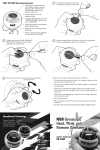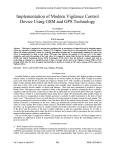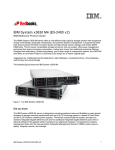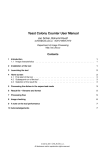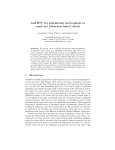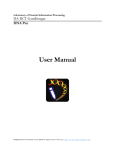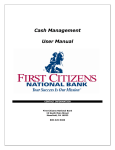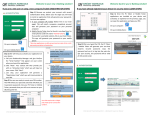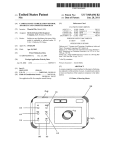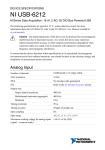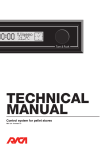Download A Secure Architecture for Mobile Agent Based Communication System
Transcript
International Journal of Latest Trends in Engineering and Technology (IJLTET) A Secure Architecture for Mobile Agent Based Communication System Swati Gupta Department of Information Technology Amity University, Noida,India Sapna Sinha Assistant Professor, Department of Information Technology Amity University, Noida, India Abstract- The development in the field of mobile communication and internet is increasing with tremendous volume. The problem with developing a secure mobile system is that the mobile users are highly dynamic in nature and keep changing their location with time. Despite of numerous practical benefits and promises of mobile agent to provide an effective way of communication, it still lacks an effective security measure which restricts its scope of applicability. In this paper our objective is to provide a highly secure environment that is simple to use and deploy. So we will work with mobile agent technology and will enhance the security of the current mobile agent based communication system. We will create a new secure protocol architecture for the mobile communication. Keyword-Mobile Agent, KDC, SMP, DMP, ASC, MC-MA-FS Model. I.INTRODUCTION In mobile based Communication System, there were many problems in network like low bandwidth, slow data rate, data are not secure. The huge demands from large number of user are pushing development of mobile communication system faster than ever before. The physical weaknesses and limitations of mobile communications like high error rate and unpredictable behaviour due to external interference are more prone to security [6]. Also limitations of wireless networks and mobile nature of users is a hurdle in providing security in a system. The network is completely available in open so it is more prone to security attacks such as interference attack. With the advancement in the application fields the more and more applications are coming such as ebanking etc, which requires highly secure systems [7]. There are so many network technologies using which we can connect computers with each other and spread information all over the world. For this purpose we can use various distributed computer resources through the computer networks. However, when any user wants to use these resources he must understand the location of distributed resources, predict their current status and select some suitable resources. MC- MA- FS model (Mobile Agent) technologies are getting popular as a means of an efficient way to access the remote resources on a distributed networks. Mobile agents are the processes that migrate from a node to node in the network autonomously to achieve result for user. The mobile agent provides the result to the user through the migration of mobile agent system without any knowledge of network environment [1].Our main objective is to provide a highly secure environment that is simple to use and deploy. So we will work with mobile agent technology and will enhance the security of the current mobile agent based communication system. In our architecture we will create a mobile agent security model by adding a security thread to the current model. II. FEATURES AND ADVANTAGES OF MOBILE AGENT Mobile Agent is a device which migrates form one host to another host in a distributed network system. 2.1 Features of Mobile Agent As mentioned in there are following features of a mobile agent. Mobility– With the help of mobility feature mobile agent migrates from one node to another node and communication processes can be performed in a wireless as well as a fixed network system. Autonomy – mobile agent program that executes autonomously on the behalf of other process. Communication – Mobile agent is capable of communicating with other mobile agent, servers (either mobile or fixed) and clients (either mobile or fixed) [8]. Learning– One of the most important feature of mobile agent is its learning ability [5]. 2.2 Advantages of Mobile Agent Vol. 2 Issue 2 March 2013 160 ISSN: 2278-621X International Journal of Latest Trends in Engineering and Technology (IJLTET) Mobile Agent has various advantages over current distributed system techniques like reduced network traffic and resource utilization. The mobile agent architecture is better than other distributed architecture as shown below- [9][10][11]. Reduce the network load - Mobile agents are also used for removing the raw information (like security thread that is added every time when information migrates) in the network. The objective of mobile agent bases communication is: move the computations to the data rather than the data to the computations [3]. Application Application Application Application Figure 1: Diagram for Reducing the Network Load Overcoming Network latency - Mobile agent can reduce network latency, robots are the real time example which responds in real time scenario. So latencies are not acceptable. A mobile agent provides a solution for the problem of latency by dispatching all the information stored on it and at the destination mobile agent act as controller so the all information’s are directly access form mobile agent. Application Node Service Provider Node Agent Migrates Service Provider Node Application Node Disconnect Application Node Service Provider Node Reconnect and come Figure 2: Diagram for Reducing Network latency Encapsulate protocols - In mobile agent system every host has its own information and a function by which a mobile agent will migrate and execute. Mobile agent contain both data as well as code this method is known as encapsulation and to provide the security on this there are some protocol defined. Two basic functions of protocol are decryption of incoming data and encryption of outgoing data. Execute asynchronously and autonomously - Mobile agent execute asynchronously and autonomously task are embedded into mobile agents, and then dispatched it .After that ,the mobile agent are independent of the creating process and can operate asynchronously and autonomously. In this time there is no need to establishment a network connection. Only after completion of task network connection is needed. Naturally heterogeneous - Mobile agent are generally independent of computer and transport layer and only dependent on their execution environment [12]. III. MOBILE CLIENT – MOBILE AGENT – FIXED SERVER MODEL (MC-MA-FS MODEL) A mobile agent is a program or object that migrates from node to node according to the application objective. At every node mobile agent checks the availability of the resources which is required and if the resource is available then it execute and completes the task, then it returns .If the required resource is not available then it Vol. 2 Issue 2 March 2013 161 ISSN: 2278-621X International Journal of Latest Trends in Engineering and Technology (IJLTET) simply migrates to the next node or disposed .In this model if a client requires the information from the server then client generates the request and sent it to the mobile agent. Then mobile agent takes information from client and move to server host. Mobile agent runs on behalf of client to give request to server host and take response of the request and get back to the client. At this time the client is free to do other work or move to other location as it is the responsibility of the mobile agent to get request from the server and give it to the client. Figure 3: MC-MA-FS Model Generally, there are multiple agents executing and performing various tasks on the same platform. In this system different agents have different property. The Mobile Client – Mobile Agent - Fixed Server is the best model in distributed system in wireless and mobile computing environment Mobile agent has ability to run over thin and think client [2]. IV. TECHNOLOGY USED IN SECURITY MODEL PROTOCOL The technologies used in security model are as follows:4.1 Aglet - Aglet is defined to be an autonomous java object that has mobility from one host to another host in a computer network environment. In other words it run’s according to its own thread of execution when it arrives at a host. It also reacts to in coming information as it is its ability [4][13]. Aglet allowsx To provide complete and easy model for programming mobile agent. x It support dynamic and powerful communication. x It provides security with the mobile agent. x To conceive a reusable and extensible architecture. 4.2 Proxy -. A proxy is used to protect aglet from open access. Location transparency is a feature of proxy which hides the location of aglet over the unsecure public network. A proxy is a representative which is used to maintain data confidentiality in aglet. 4.3 Context - The workplace of an aglet is context. It is responsible for the management of aglets which are in running mode in a uniform execution environment and it secures the host from malicious aglets. In computer networks each node is capable to provide functionality of multiple servers and each server can configure multiple contexts .Contexts can be located over the network by their name which includes context’s server address and context name. 4.4 Message - The exchange of messages in aglet knows as object. It can support two types of message passing – synchronous and asynchronous message passing between aglets. Aglets can exchange information in a loosely coupled fashion. 4.5 Future reply - Asynchronous message sending is used as a handler to collect the results for future reply. 4.6 Identifier - An aglet contains an identifier which is unique and immutable throughout the life span of the aglets. V.ARCHITECTURE OF EXISTING SECURITY MODEL Vol. 2 Issue 2 March 2013 162 ISSN: 2278-621X International Journal of Latest Trends in Engineering and Technology (IJLTET) Figure 4: Architecture of Current Security Model In the above scenario, there is a source mobile host which need to connect to the destination mobile host .source mobile host send a request to key distribution centre (KDC) for the authentication password to connect to the destination mobile host . Now source mobile host’s mobile agent migrates the destination mobile host and tries to communicate with it .To verify authenticity of the mobile agent, destination mobile host send the authentication request to the KDC. KDC sends back the password .if the password is correct then mobile agent’s request is fulfill and mobile agent return backs to its source. If the password is not correct then the mobile agent is not accepted. Following are the disadvantages in current systemx Model is a very sophisticated model. x There is need to manage the location of the agent. x When the mobile agent is migrating from source to destination ,if mobile agent is modified then destination will not be able to identify the changes. VI. ARCHITECTURE OF PROPOSED SECURITY MODEL In our proposed model we are trying to remove different security problem of mobile agent based system by adding a security thread. On the mobile Platform, there is static mobile agent with the help of which we add Security thread in Dynamic mobile agent. So that static mobile agent will have the following tasks x x To find authentication key for mobile agent. Encrypt dynamic mobile agent Figure 5: Architecture of Security Model Vol. 2 Issue 2 March 2013 163 ISSN: 2278-621X International Journal of Latest Trends in Engineering and Technology (IJLTET) x Find out MD5 of Dynamic mobile agent. x Send mobile agent to a destination. x And display the result got by mobile agent. Add Security Thread:-The main objective of our work is to protect mobile agent and mobile platform. In this security thread we are using MD5 (Message Digest 5) one way hash functions. With the help of MD5 we insure that our data or code cannot be interrupted (modify) by any Malicious Host or Malicious Agent [8]. x Encrypt dynamic mobile agent. x Find out the MD5 of the migrating mobile agent. x Send the mobile agent to the destination. KDC (Key Distribution Center) - KDC is just like a central server that provides the authentication passwords for all mobile agents. Key Distribution Center generates nine characters (bytes) password that is distributed to all mobile agents, by using public encryption (digital signature). When mobile agent move from one platform to another platform both static and dynamic agent will be authenticated by exchanging their password. Check Security Thread - Before the execution of the application, check security thread read information about the mobile agent that is – x Decrypt dynamic mobile agent x Find out the MD5 of the coming mobile agent and check this is same or not. x If yes then execute otherwise ignore that mobile agent (dispose). VIII. CONCLUSION In this paper, we have proposed the framework of security architecture for Mobile agent based communication, along with partial implementation of the system. The design is quite general, so that it can be easily integrated into other mobile agent systems. More over our focus is over an application-layer security for agent based communication to provide end to end authentication and data confidentiality between mobile agents. We have suggested two- way authentication architecture to authenticate mobile agents. This solution can be implemented in aglet (Java based technology) without any changes in underlying protocols and mobile agent communication infrastructure. REFERENCES [1] Jailani, N., Yatim, N. F. M., Yahya, Y., Patel, A., & Othman, M. (2008). Secure and auditable agent-based e-marketplace framework for mobile users.Computer Standards & Interfaces, 30(4), 237-252. [2] Wang, A., Sørensen, C. F., &Indal, E. (2003, July). A mobile agent architecture for heterogeneous devices. In In Proc. of the Third IASTED International Conference on Wireless and Optical Communications (WOC 200). [3] Overeinder, B., Oey, M., Timmer, R., van Schouwen, R., Rozendaal, E., & Brazier, F. (2010). Design of a secure and decentralized location service for agent platforms. Agents and Peer-to-Peer Computing, 97-109. [4] Roth, V. (2002). Programming Satan's agents. Electronic Notes in Theoretical Computer Science, 63, 124-139. [5] Picco, G. P. (Ed.). (2001). Mobile Agents: 5th International Conference, MA 2001 Atlanta, GA, USA, December 2-4, 2001 Proceedings (Vol. 5). Springer [6] O’Grady, M. J., & O’Hare, G. M. (2005). Mobile devices and intelligent agents—towards a new generation of applications and services. Information Sciences,171(4), 335-353. [7] Horling, B., & Lesser, V. (2004).A survey of multi-agent organizational paradigms. The Knowledge Engineering Review, 19(4), 281316. [8] Pandey, A. (2007). Security on Mobile Agent Based Communication System. [9] Lange, D. B., &Oshima, M. (1998). Introduction to mobile agents. Personal and Ubiquitous Computing, 2(2), 49-56. [10] Shiao, D. (2004). Mobile agent: new model of intelligent distributed computing.IBM China, October. [11] Lange, D. B., &Oshima, M. (1999).Seven good reasons for mobile agents.Communications of the ACM, 42(3), 88-89. [12] Brazier, F. M. T., Overeinder, B. J., Van Steen, M., &Wijngaards, N. J. E. (2002, March). Agent factory: Generative migration of mobile agents in heterogeneous environments. In Proceedings of the 2002 ACM symposium on Applied computing (pp. 101-106).ACM. [13] Ferrari, L. (2004). The aglets 2.0. 2 user's manual. 2010-04-03]. http://aglets.sourceforge. net. Vol. 2 Issue 2 March 2013 164 ISSN: 2278-621X





